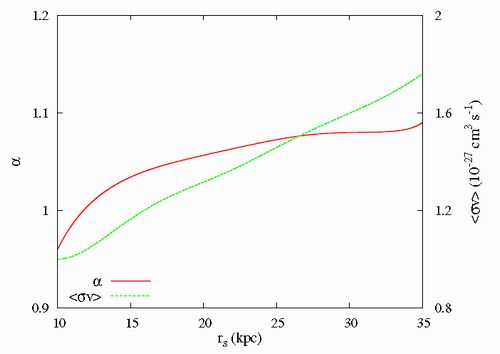|
|

|
 |
|
 |
|
|
 |
|
 |
 |
|
 |
|
| Constraining the Distribution of Dark Matter in the Inner Galaxy with an Indirect Detection Signal: The Case of a Tentative 130 GeV γ-Ray Line |
| Author: |
|
Update time: |
2013-08-01 |
Dark matter distribution in the very inner region of our Galaxy is still debated. In N-body simulations, a cuspy dark matter halo density profile is favored. Several dissipative baryonic processes, however, are found to be able to significantly flatten dark matter distribution, and a cored dark matter halo density profile is possible. Baryons dominate the gravitational potential in the inner Galaxy, hence a direct constraint on the abundance of dark matter particles is rather challenging. Recently, a few groups have identified a tentative 130 GeV line signal in the Galactic center, which could be interpreted as the signal of dark matter annihilation. Using current 130 GeV line data and adopting the generalized Navarro-Frenk-White profile of the dark matter halo—local dark matter density ρ0 = 0.4 GeV cm-3 and r s = 20 kpc—we obtain a 95% confidence level lower (upper) limit on the inner slope of dark matter density distribution, α = 1.06 (the cross section of dark matter annihilation into γ-rays langσvrangχχ → γγ = 1.3 × 10-27 cm3 s-1). Such a slope is consistent with the results of some N-body simulations and, if the signal is due to dark matter, suggests that baryonic processes may be unimportant. 
Ninety-five percent confidence level lower (upper) limit on the generalized NFW distribution parameter α (σvχχ→γγ ) set by current 130 GeV line data for ρ0 = 0.4 GeV cm.3. Following Iocco et al. (2011), rs is restricted within the range 10–35 kpc. By with YANG Ruizhi The 95% confidence level lower (upper) limit on the generalized NFW distribution parameter α (⟨σv⟩χχ→γγ) set by current 130 GeV line data for ρ0 = 0.4 GeV cm−3. Following ?, rs is restricted within the range 10 − 35 kpc. The work by YANG Ruizhi,has been accepted to be published in the ApJ, please see ApJ, 770, 127 for more details.(http://iopscience.iop.org/0004-637X/770/2/127/) |
|
|
|
 |
|
 |
|
|
Copyright? Purple Mountain Observatory, CAS, No.10 Yuanhua Road, Qixia District, Nanjing 210023, China
Phone: 0086 25 8333 2000 Fax: 8333 2091 http://english.pmo.cas.cn |
|
|
